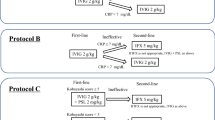Abstract
We studied the effects of a new regimen consisting of intravenous immune globulin (IVIG) combined with dexamethasone (DEX) on clinical outcome and serum levels of vascular endothelial growth factor (VEGF) in the initial treatment of Kawasaki disease (KD). A total of 46 KD patients received 0.3 mg/kg per day DEX plus heparin i.v. for 3 consecutive days, together with 2 g/kg IVIG over 4 to 5 days (DEX group). Low-dose acetylsalicylic acid was started after completion of DEX therapy. The control group consisted of 46 KD patients retrospectively treated earlier with 2 g/kg IVIG over 4 to 5 days plus higher dose acetylsalicylic acid (CONTROL group). No serious adverse effect was noted in either group. There were no differences in baseline and post-treatment laboratory data except for C-reactive protein between the groups. Post-treatment C-reactive protein in the DEX group (median 0.9 mg/dl, range 0.0 to 24.7 mg/dl) was lower than that (1.2 mg/dl, range 0.2 to 19.5 mg/dl) in the CONTROL group ( P =0.033 by Mann-Whitney U test). In addition, the mean duration of fever after the first IVIG infusion was 2.2 days (median 1 day, range 1 to 12 days) in the DEX group and 2.8 days (2 days, 1 to 16 days) in the CONTROL group ( P =0.015 by Mann-Whitney U test). The new regimen did not reduce VEGF levels. Two patients in each group developed small- or medium-sized coronary artery aneurysms. Conclusion:although this regimen did not affect coronary outcome, intravenous immune globulin therapy combined with dexamethasone for the initial treatment of Kawasaki disease was safe and may accelerate the resolution of systemic inflammation.

Similar content being viewed by others
Abbreviations
- CAA :
-
coronary artery aneurysms
- DEX :
-
dexamethasone
- IVIG :
-
intravenous immune globulin
- KD :
-
Kawasaki disease
- VEGF :
-
vascular endothelial growth factor
References
Chrousos GP, Margioris AN (2000) Adrenocorticosteroids and adrenocortical antagonists. In: Katzung BG (ed) Basic and clinical pharmacology. Lange Medical Books/McGraw-Hill, New York, pp 660–678
Couser RJ, Ferrara TB, Falde B, Johnson K, Schilling CG, Hoekstra RE (1992) Effectiveness of dexamethasone in preventing extubation failure in preterm infant at increased risk for airway edema. J Pediatr 121: 591–596
Hashino K, Ishii M, Iemura M, Akagi T, Kato H (2001) Re-treatment for immune globulin-resistant Kawasaki disease: a comparative study of additional immune globulin and steroid pulse therapy. Pediatr Int 43: 211–217
Ikeda Y, Carson BS, Lauer JA, Long DM (1993) Therapeutic effects of local delivery of dexamethasone on experimental brain tumors and peritoneal brain edema. J Neurosurg 79: 716–721
Japan Kawasaki Disease Research Committee (1984) 1984 Diagnostic guidelines of Kawasaki disease, 4th rev. edn. Japan Kawasaki Disease Research Committee, Tokyo
Kawasaki T (1967) Acute febrile mucocutaneous syndrome with lymphoid involvement with specific desquamation of the fingers and toes in children: clinical observations of 50 cases (in Japanese). Arerugi 16: 178–222
Koedam JA, Smink JJ, van Buul-Offers SC (2002) Glucocorticoids inhibit vascular endothelial growth factor expression in growth plate chondrocytes. Mol Cell Endocrinol 197: 35–44
Lassus P, Nupponen I, Kari A, Pohjavuori M, Andersson S (2002) Early postnatal dexamethasone decreases hepatocyte growth factor in tracheal aspirate fluid from premature infants. Pediatrics 110: 768–771
Maeno N, Takei S, Masuda K, Akaike H, Matsuo K, Kitajima I, Maruyama I, Miyata K (1998) Increased serum levels of vascular endothelial growth factor in Kawasaki disease. Pediatr Res 44: 596–599
Newburger JW, Takahashi M, Beiser AS, Burns JC, Bastian J, Chung KJ, Colan SD, Duffy CE , Fulton DR, Glode MP, Mason WH, Meissner HC, Rowley AH, Shulman ST, Reddy V, Sundel RP, Wiggins JW, Colton T, Melish ME, Rosen FS (1991) A single intravenous infusion of gamma globulin as compared with four infusions in the treatment of acute Kawasaki syndrome. N Engl J Med 324: 1633-1639
Nonaka Z, Maekawa K, Okabe T, Eto Y, Kubo M (1995) Randomized controlled study of intravenous prednisolone and gammaglobulin treatment in 100 cases with Kawasaki disease. In: Kato H (ed) Kawasaki disease. Proceedings of the 5th International Kawasaki Disease Symposium. Elsvier Science BV, Amsterdam, pp 328–331
Ohno T, Yuge T, Kariyazono H, Igarashi H, Joh-o K, Kinugawa N, Kusuhara K, Hara T (2002) Serum hepatocyte growth factor combined with vascular endothelial growth factor as a predictive indicator for the occurrence of coronary artery lesions in Kawasaki disease. Eur J Pediatr 161: 105–111
Sato N, Sugimura T, Akagi T, Yamakawa R, Hashino K, Eto G, Iemura M, Ishii M, Kato H (1999) Selective high dose gamma-globulin treatment in Kawasaki disease: assessment of clinical aspects and cost effectiveness. Pediatr Int 41: 1–7
Shinohara M, Sone K, Tomomasa T, Morikawa A (1999) Corticosteroids in the treatment of the acute phase of Kawasaki disease. J Pediatr 135:465–469
Shulman ST, De Inocencio J, Hirsch R (1995) Kawasaki disease. Pediatr Clin North Am 42: 1205–1222
Sundel RP, Baker AL, Fulton DR, Newberger JW (2003) Corticosteroids in the initial treatment of Kawasaki disease: report of a randomized trial. J Pediatr 142: 611–616
Terai M, Shulman ST (1997) Prevalence of coronary artery abnormalities in Kawasaki disease is highly dependent on gamma globulin dose but independent on salicylate dose. J Pediatr 131: 888–893
Terai M, Honda T, Yasukawa K, Higashi K, Hamada H, Kohno Y (2003) Prognostic impact of vascular leakage in acute Kawasaki disease. Circulation 108: 325–330
Wright DA, Newburger JW, Baker A, Sundel RP (1996) Treatment of immune globulin-resistant Kawasaki disease with pulsed doses of corticosteroids. J Pediatr 128: 146–149
Yasukawa K, Terai M, Shulman ST, Toyozaki T, Yajima S, Kohno Y, Rowley AH (2002) Systemic production of vascular endothelial growth factor and fms-like tyrosine kinase-1 receptor in acute Kawasaki disease. Circulation 105: 766–769
Author information
Authors and Affiliations
Corresponding author
Rights and permissions
About this article
Cite this article
Jibiki, T., Terai, M., Kurosaki, T. et al. Efficacy of intravenous immune globulin therapy combined with dexamethasone for the initial treatment of acute Kawasaki disease. Eur J Pediatr 163, 229–233 (2004). https://doi.org/10.1007/s00431-003-1386-5
Received:
Accepted:
Published:
Issue Date:
DOI: https://doi.org/10.1007/s00431-003-1386-5




